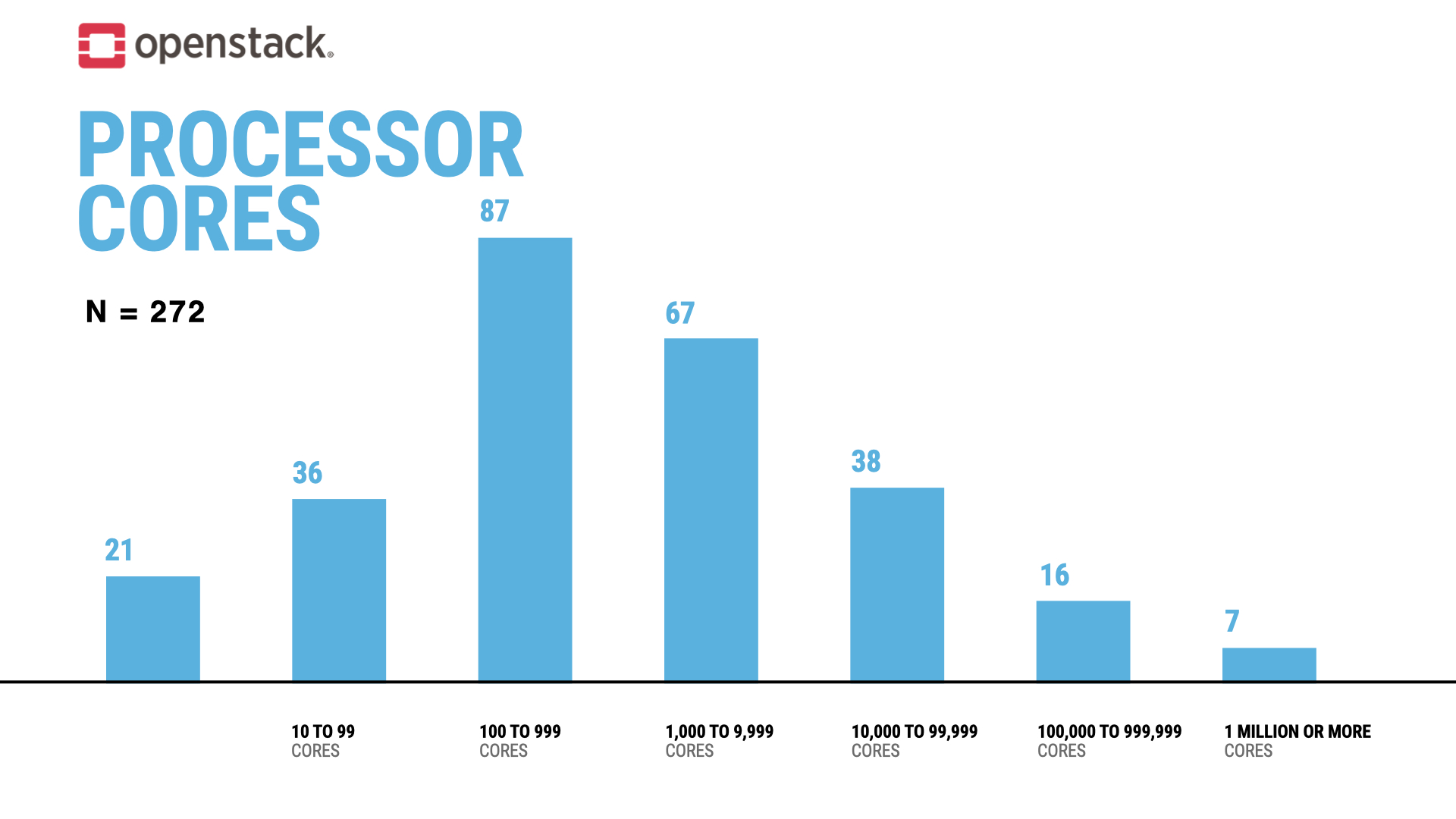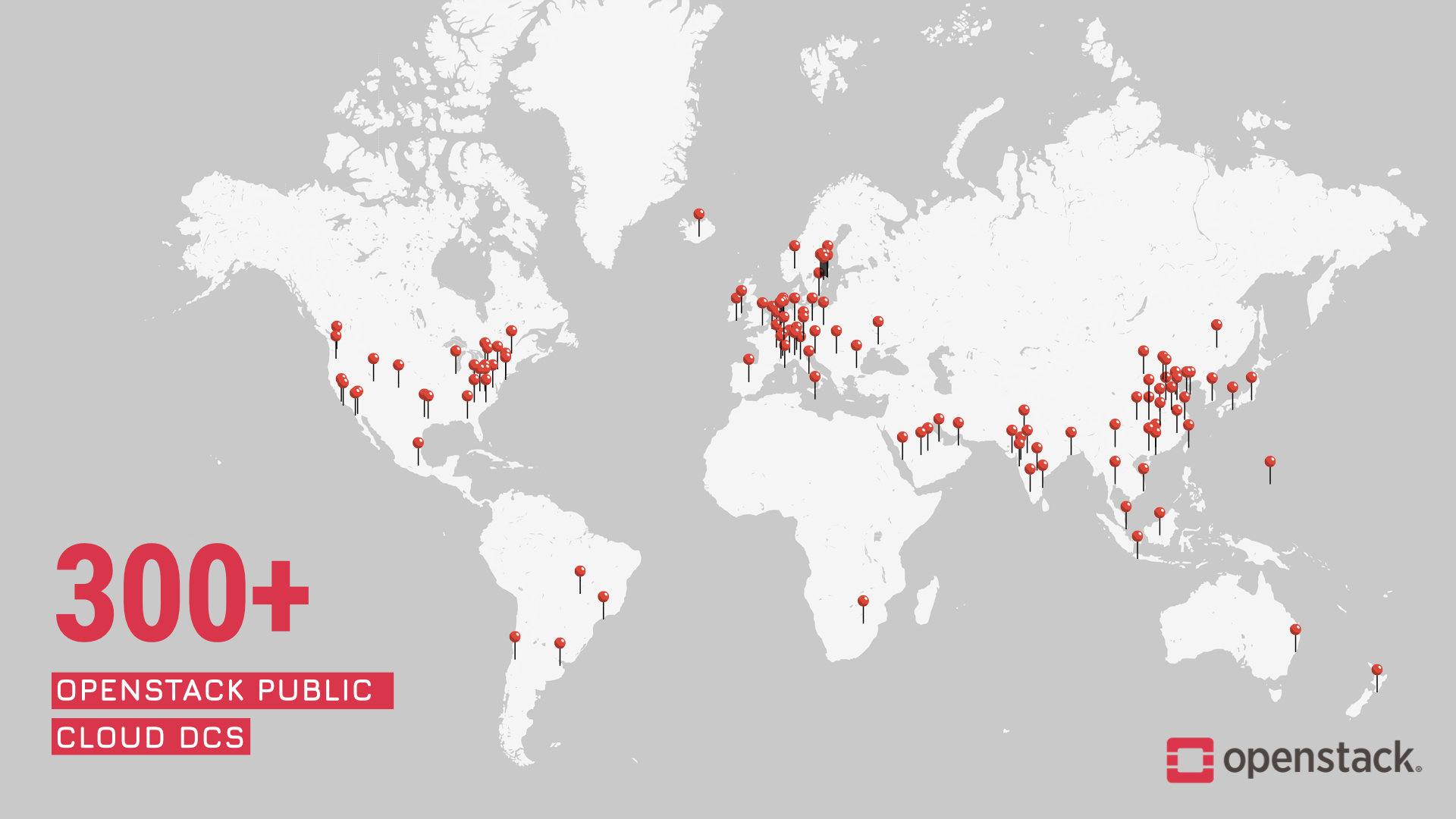Executive Summary
OpenStack is More Alive Than Ever with 40 Million Cores in Production and Over 300 Public Cloud Data Centers Worldwide
Exponential growth driven by increased reliance on hybrid cloud environments and Kubernetes integration support.
At a time when pundits question if OpenStack—the fourth largest open source project in the world—is dead, the OpenInfra Foundation measured an unprecedented 40 million cores of OpenStack in production. Adoption of core services—Nova, Neutron, Keystone, Glance and Ironic—remain high, but as operators evolve their architecture to accommodate new workloads, they have turned to supporting services under the OpenStack umbrella including Octavia and Magnum. These specific projects support the reliance on hybrid cloud environments and integration with Kubernetes, respectively, and are continuing to grow as production-ready OpenStack services.
This survey represented in this report captures over 300 deployments and feedback from over 430 respondents cataloged between August 2021 and August 2022. Names of specific user organizations and individual respondents are kept anonymous unless specific permission has been used to include in the report.
Size of OpenStack Deployments
OpenStack Production Deployment Core Count Surges As Users Document Growth Among Environments of All Sizes
OpenStack deployments hit a new milestone in 2022, reaching 40 million compute cores in production, a 60% increase compared to 2021 and an impressive 166% increase since 2020. Deployments continue to vary in size, with the majority of deployments (56%) falling between 100 and 10,000 cores.

A significant amount of the core growth was documented by the members of the Million Core Club, a group launched in 2021 to recognize the largest OpenStack deployments in the world. LINE is an instant messaging service based in Japan with 176 million active monthly users in the major four markets. Their cloud powered by OpenStack increased its footprint to 4 million cores, a 150% increase compared to 2021. Workday, an on-demand, cloud-based financial management, human capital management and student information system software vendor, doubled their OpenStack footprint again this year to 2.84 million cores.
But it’s not just the largest OpenStack deployments that comprise this explosive growth. Organizations of all sizes are scaling significantly to address the requirements of their end users. Notable examples include:
- Schwarz IT, the IT organization of Europe’s biggest retail group, which includes Lidl, Kaufland, and several production and recycling companies, increased its OpenStack footprint over 160% to 15,000 cores compared to 5,700 cores in 2021.
- One of the top 10 telcos in Europe increased its OpenStack footprint to 120,000 cores, a 131% increase compared to its 52,000 core footprint in 2021.
- An American video game developer increased its large-scale OpenStack deployment to 650,000 cores, a 20% increase compared to its 540,000 core footprint in 2021.
- OVH, a European based public cloud is drawing close to becoming a Million Core Club member, citing a footprint of 900,000 cores, an increase of 10% from 2021.
OpenStack Public Cloud Footprint
OpenStack-Powered Public Cloud Footprint Exceeds 300 Data Centers Worldwide
Open source public cloud options are increasingly becoming the deployment model of choice, especially among organizations who are accommodating compliance standards, like GDPR and other digital sovereignty laws. OpenStack-powered public clouds provide the scalability you’d expect with a public cloud provider along with specialists who can provide customized support based on regional regulations.
"As the only OpenInfra Gold Member in Thailand, it’s exciting to see more organizations in southeast Asia join us in leveraging the flexibility and cost efficiency of OpenStack. We are honored to be a part of the rapidly growing, global footprint of OpenStack powered public clouds."
-- Abhisak Chulya, CEO, NIPA Cloud

The OpenInfra Standard Adoption Growth
LOKI Implementation Continues to Rise, Supported by Increased Adoption of Magnum
Linux OpenStack Kubernetes Infrastructure (LOKI) is being implemented in production at an increasing rate as the OpenInfra standard. Kubernetes is now deployed on over 85% of OpenStack deployments: 73% through vanilla Kubernetes and an additional 12% through OpenShift. The rise in OpenStack and Kubernetes production integrations is further documented by an increase to 21% (up from just 16% last year) of users running production workloads with Magnum, the OpenStack service for container orchestration.
“Over the last couple of years, more customers are using OpenStack and OpenShift together in different deployment models. At Red Hat, we have done a ton of work to make sure that these platforms can be used together, so users are no longer faced with a decision between one platform or the other, but rather can freely and confidently choose the configuration where their current and future workloads are served best.” —Maria Bracho, manager of product management, Red Hat
Hybrid Cloud Trends
Octavia Adoption Increases to Support Growing Use of Hybrid-Cloud Environments with OpenStack
According to Flexera’s 2022 State of the Cloud report, 80% of respondents are taking a hybrid approach by combining the use of both public and private clouds. This trend is reflected in the OpenStack User Survey as respondents running a hybrid cloud environment with their OpenStack deployment has risen from 77% to 80%. To enable the smooth transition of workloads across different cloud environments, an increasing number of operators are turning to Octavia, an open source, operator-scale load balancing solution designed to work with OpenStack. Almost half of production deployments are running Octavia in production, an 11% increase from last year.
New OpenStack Deployment Regions
New OpenStack Data Center Regions Reflected in Growing OpenInfra Foundation Membership
OpenStack historically has seen widespread adoption by data centers in North America, Europe and Asia, specifically in China. This year, new data centers have been launched in regions that have historically not seen quite as much activity. OpenStack-based datacenters have launched this year in Africa, South America, and additional countries in Asia, leading to increased collaboration and investment between organizations in these regions and the OpenInfra Foundation. Within the past year, Nipa Cloud, Atlancis, Viettel, NHN Cloud, Okestro and the University of Delhi have joined the OpenInfra Foundation to support the mission of building open source communities who write software that runs in production.
OpenStack NPS
OpenStack User Satisfaction Stable with NPS of 41
The OpenStack project continues to be one of the top four most active open source projects in the world, so it’s not surprising that one of the most common satisfaction points among OpenStack users is the supportive community. Users praise the community for “The sheer technical talent that it has been able to nurture and give back” and cite “community encouragement and support” and the “community-driven” nature of the project among its greatest strengths. Survey respondents also laud:
- The broad ecosystem supporting the projected $7.7 billion OpenStack market.
- The scalability of the software which has increased the global OpenStack footprint 166% in two years.
- The breadth of features that allows for increased customization.
- Standardized APIs.
That said, every project has opportunities to improve. Among survey respondents, upgrades continue to be the number one pain point, but the community has listened and a significant change in approach will begin with the next release. The OpenStack Antelope release, scheduled for March 2023, will be the first in the Skip Level Upgrade Release Process (SLURP) cadence recently established by the Technical Committee. Every other release will be considered to be a “SLURP” release. Deployments wishing to stay on the six-month cycle will deploy every “SLURP” and “not-SLURP'' release as they always have. Deployments wishing to move to a one-year upgrade cycle will synchronize on a “SLURP” release, and then skip the following “not-SLURP'' release, upgrading when the subsequent “SLURP” is released. The community is hopeful that this alleviates some of the complexities within the OpenStack upgrade process.
The community is also addressing user requests for dashboard improvements. In the OpenStack Zed release, distributed in October 2022, the community introduced OpenStack Skyline, a new OpenStack dashboard project with original code contributed by 99Cloud. Using a technology stack based on React, Skyline features a more modern webapp architecture and is designed to handle user requests and multiple current commands more gracefully than Horizon, the canonical implementation of OpenStack’s dashboard. Skyline is considered by the OpenStack Technical Committee to be in an "emerging technology state,” not yet ready for production, but the project is on track to provide a strong upgrade to the OpenStack dashboard.
Other areas of improvement needed, according to survey respondents, are the documentation for the project and reducing OpenStack’s overall complexity. Both of these are issues that the community leadership is actively addressing. If you’re interested in getting involved, your contributions are welcome. Visit openstack.org/community to learn more.